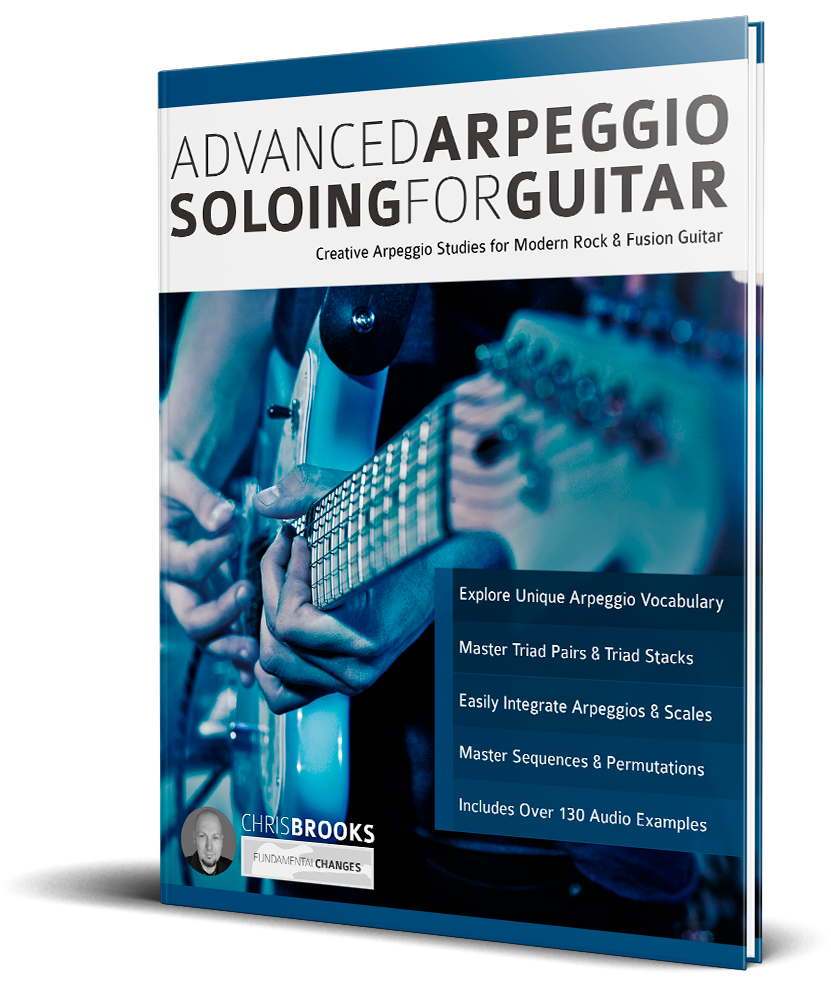
Many books either regurgitate existing material or simply present all the possibilities for a certain topic. The problem with this is that although the material is correct, it lacks the curation from the eyes of an experienced player and educator.
In this book from Australian-based guitarist, recording artist and educator Chris Brooks, he continues to examine deeper into the material he presented in his last book, Sweep Picking Speed Strategies For Guitar (reviewed last November here). Going beyond the technical aspects of sweep picking, this book is coming from a musical perspective. Concepts like Triad Pairs, Triad Stacks, combining arpeggios and scales as well as a deep look into sequences and permutations are covered in this 100-page book.
The book is made of 6 chapters that are very logically organised. The book begins with an introduction followed by some background music theory and sweep picking technique terminology. More advanced guitarists may skip this but for those who need a theory refresher, this section is useful!
Chapter one goes deep into the use of triad pairs. Chris is very thorough, giving fretboard diagrams of the triad pairs (across the entire fretboard and on various string sets) as well as arpeggios speed shapes (optimised for sweep picking). Major, minor and mixed triad pairs are covered giving a diversity of harmonic possibilities. The written examples cover Dorian, Phrygian, Lydian, Mixolydian, Hamonic minor, Phrygian Dominant, Melodic Minor, Altered and whole-half diminished scale sounds. In the musical examples, analysis, left hand fingering and every picking direction are indicated throughout the book. This is great as I’ve personally been frustrated with books that do not go to this level of detail (and made me feel lost).
In the second chapter, Chris introduces an interesting way of looking at using triads via a process called triad stacking. This opens up various substitutions that imply extended and modal harmony in your solos. These arpeggios line examples are interesting and move across the fretboard. To make the arpeggiated lines more lyrical, Chris includes slides, hammer-ons and pull-offs as well. My favorite part of this chapter is his vertical triad stack and 7ths stacks section. He attributes his discovery of this sound from listening to Richie Kotzen. Personally, this is a sound that I love using as well so it’s great to see how Chris teaches this concept. Chris also includes his favorite pairs and stacks at the end of the chapter. Very useful stuff!
Chapter three goes into the very rock centric topic of sequencing. He shares insights he’s gained from studying Yngwie Malmsteen, Paul Gilbert, Vinnie Moore and Greg Howe’s personal approaches to this topic. I really enjoyed how he organised and named the sequences for easier study (in terms of identification, not necessarily from a technical execution perspective). These are very powerful ideas that definitely will result in better flowing arpeggio technique!
Chapter four goes into how to incorporate arpeggios smoothly with scalar lines. Chris gives examples of 3 different scale picking approaches including alternate picking, economy picking and compound picking (The Yng Way) – which is covered in depth in his previous books and materials.
Chapter five aptly nicknamed “Snazzier and Jazzier” goes into extended arpeggios within diatonic major scale harmony. As with the previous chapters, there’s plenty of examples to dig into here.
Chapter six closes with phrasing ideas to create stronger and more interesting lines. He goes into rhythmic ideas, dynamics, articulation and control. Closing the chapter are 3 short solos with the melodic concepts (note choices) explained for each chord in the solo. This is a useful addition to the book for players to see how the many concepts in the book work together in a musical situation.
In conclusion, this is a knowledge-dense book from a dedicated musician and educator. The attention to detail throughout the book is to be applauded. If you’re even remotely interested to develop your arpeggio based soloing skills, you will definitely gain something from this book. I would recommend getting all of Chris’s books as they do form a unified (and personal) take on lead guitar soloing development. If you’re into modern rock and fusion guitar, this book will be able to provide hours of practice. Strongly recommended!
Pros: Very systematic and in-depth book on this topic!
Cons: None.
TLDR: If you’ve worked on any of Chris Brook’s earlier books or material, this book is a worthy addition to your collection.
I received a review copy of this book from Fundamental Changes. Thank you Joseph and Amanda!
You can get the book here:
https://www.fundamental-changes.com/book/advanced-arpeggio-soloing-for-guitar/
[Review Archive]
I wrote a lot of other book, course and video reviews too.
Check out the rest here:
[Read more reviews]
[Submissions for Review Consideration]
- Are you an author who wrote a jazz, guitar or music book?
- Have you created a DVD or an online video course or subscription based website?
- Would you like me to review your book/course?
Please send me a message at azsamad2 at gmail.com with:
For courses: a link to the course/video/product + access info etc.
For books: a link to the book (Dropbox) or PDF attachment (if it’s small) for review consideration.
Depending on whether I dig the book/course, I’ll let you know if I do plan to review it!
I cannot guarantee a review for every submission & if I’m not too into it, I may opt not to review it. I mean, it’s better to get a good review that for me to write a bad review just because it’s not a match for the kind of stuff I dig right? :p
NOTE: All reviews reflect my honest personal opinion so be aware that I will point out both cool Pros and Cons that I see in the work. You dig? 🙂
Leave a Reply